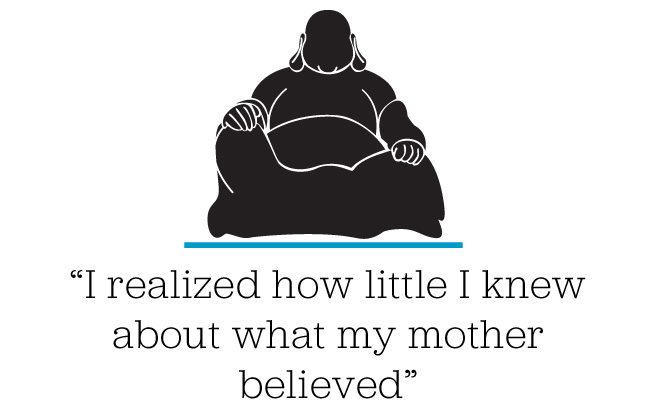Memoir: after my mother died, I found solace in her religion


My mother used to compare Buddhism to a boulder in a rushing river: something you could grab onto whenever you needed it, an anchor in moments of chaos. After the fall of Saigon in 1975, we left our Vietnamese village on a fishing boat. When we settled in Regent Park, my father toiled as a mechanic, my mother as a seamstress—they were always working to make a better life for my two siblings and me. Throughout my childhood, my mother would pray to the ancestors for guidance or good fortune. She’d set up an altar, place food on a wooden table by the window, and burn candles and incense to create an auspicious crosswind. My father was skeptical of her practice; he thought religion was a hobby for the ignorant. I tended to agree with him.
My mother passed away from lymphoma last December. By the time we got to the hospital, before sunrise, she was already gone. From her hospital bed, I called her six younger siblings in Los Angeles to break the news. When I reached my aunt Angie, she was aghast. “This can’t be,” she said. “You didn’t get a Buddhist monk to chant her last rites by her bedside before she died?” I realized how little I knew about my mother’s religious beliefs, what to do at the moment of her passing, and what was important to her.
Death is the most important stage in the cycle of Buddhism—it sets the path toward reincarnation. I started to plan a proper Buddhist funeral. My aunts put me in touch with a monk from Montreal who was a family friend from the village of our ancestors. She consulted the scriptures and determined that Tuesday would be the ideal day for the funeral, based on my mother’s astrological sign, birthday and date of death. But that wasn’t convenient for my aunts flying in from L.A. I lifted myself out of the situation and let my aunts hammer out the details with the monk over Skype.
They settled on three weeks after the death. I spent the intervening days in a total panic, too flustered by all the planning to grieve. My mother didn’t want to be cremated—she was afraid of the heat—so we opted for a burial. I found her a shady plot at Mount Pleasant Cemetery; the monk said it was important that the site face east, so that when her soul rose toward the afterlife, it would face the heavens. When my aunts arrived from L.A., they brought boxes full of funeral supplies: incense, paper gold bullion to bury with the body (heaven is expensive) and white cotton banners with Chinese calligraphy that identified the names of the mourners. (They saw Canada as a cultural hinterland and worried there would be nowhere to buy that stuff here.) I left a pair of socks that I’d knitted for her in the casket, so her feet would stay warm on the long journey ahead.
The funeral lasted two days. On the first, a group of monks displayed her open casket in a crypt, chanting prayers and inviting visitors to bow to her body. The second day was more intimate—just family and the monks, who chanted and dipped flowers in water, sprinkling the life force onto her head. My father, my siblings and I walked backward to the hearse to show our regret for the loss, while our extended family walked toward us as a sign of love and condolence. It was surreal and surprisingly powerful.
The monk informed me that the next 100 days were critical to the Buddhist mourning process—only through consistent prayer can mourners guarantee that their loved one will ascend to the afterlife. We began visiting a temple at Queen and Greenwood. It was a lush space filled with golden statues of the Buddha, red carpets and the aroma of sandalwood. Every Sunday, my brother and I visited for four hours of prayer; my father chose to grieve in his own way, as did my sister, who lives in Ottawa. We would sit in front of the congregation, wearing ceremonial white headbands and bowing to the statues. For the first few weeks, I dreaded the obligation. I’d roll out of bed and head to the temple, my stomach grumbling with anxiety. Soon I realized I was being ridiculous: my mother had borne us, carried us in her arms through the Vietnamese mangroves to escape persecution, scrounged to feed us her entire life. I recognized what it meant to be grateful and began looking forward to my visits. The rituals took me out of the real world, into a tranquil space of incense and melody. The temple was a place where I could stop and remember my mother.
After the prayers, we’d sit with 20 other mourners who’d lost someone, facing the wall of the dead, where people posted photos of their relatives and made offerings in their memory. My mother loved flowers, so I always brought fresh-cut white lilies; the smell reminded me of her favourite perfume, Chanel No. 5. I never spoke to my fellow congregants, but I remember them vividly. We were all mourning together, and that gave me solace.
On the 100th day, we left the temple for the last time and went to my father’s house, where we set up an altar to celebrate my mother’s memory. The following Sunday, I was surprised to find how much I missed the ceremony of remembering her. She is always with me, everywhere and nowhere, as is the ritual that helped me come to terms with her death. Like her, I’d found religion when I needed it the most.
Hon Lu manages environmental projects at Infrastructure Ontario.
Email submissions to memoir@torontolife.com






This is beautiful. In death we find the rituals of our people most meaningful. My condolences to you and your family.